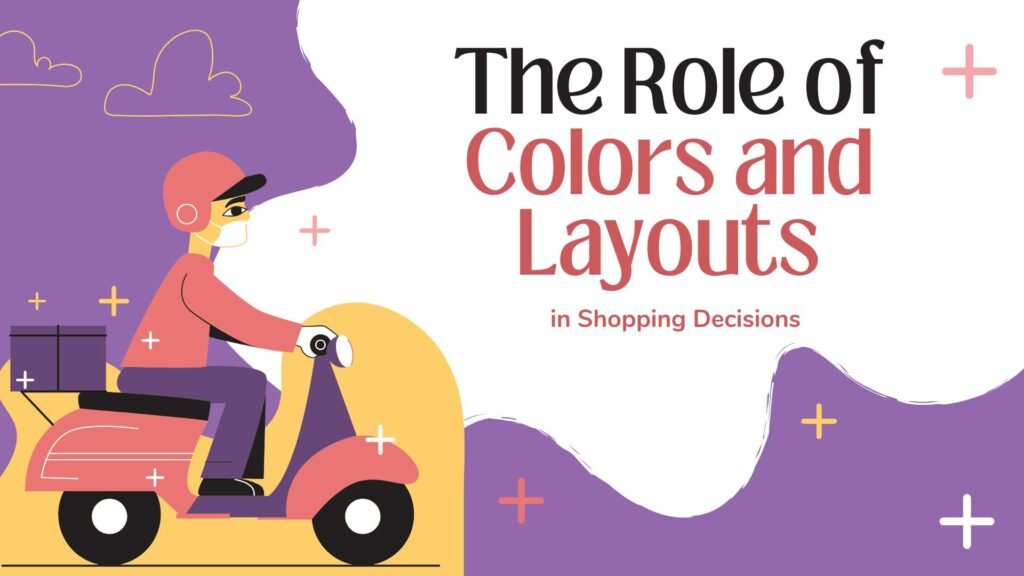Colors and layout play a crucial role in influencing shopping behavior. Whether you’re designing a physical store, an e-commerce website, or a product, understanding how these elements impact consumer decisions can help you drive sales and create a memorable brand experience. Let’s explore how colors and layouts shape the psychology of shopping.

1. The Psychology of Colors in Shopping
Colors evoke emotions, create associations, and influence perceptions. Here’s how different colors impact consumer behavior:
- Red: Creates a sense of urgency and excitement. It’s often used in sales tags and clearance sections to encourage quick decisions.
- Blue: Evokes trust, calmness, and reliability. Popular among financial institutions and tech brands.
- Yellow: Associated with optimism and cheerfulness, it grabs attention and is often used in window displays.
- Green: Represents nature, health, and eco-friendliness. Commonly used by sustainable brands.
- Black: Signifies luxury and sophistication. Often used in high-end product branding.
- White: Conveys simplicity and cleanliness, making it ideal for minimalist designs.
2. How Layout Impacts Shopping Decisions
The layout of a store or website significantly influences how customers navigate and engage. A well-structured layout can:
- Guide Customer Flow: In physical stores, strategic placement of aisles and shelves encourages exploration. For websites, intuitive navigation ensures users find what they need quickly.
- Highlight Key Products: Use focal points like end caps or hero banners to draw attention to featured items.
- Reduce Decision Fatigue: Too many options can overwhelm shoppers. Group related items logically to simplify decision-making.
- Create a Comfortable Experience: Spacious layouts reduce stress, while cluttered designs can drive customers away.
3. Combining Colors and Layout for Maximum Impact
The synergy between colors and layout can make or break a shopping experience. Here are some tips:
- Create a Visual Hierarchy: Use contrasting colors and strategic placement to guide the shopper’s eye to high-priority areas, like discounts or new arrivals.
- Optimize for Branding: Ensure that colors and layouts align with your brand identity. For example, eco-conscious brands might use earthy tones and natural textures.
- Utilize Color Psychology Online: Highlight call-to-action (CTA) buttons with bold, contrasting colors to increase click-through rates.
- Test and Adapt: A/B testing can help identify which color schemes and layouts drive the most engagement and conversions.
4. Case Studies of Effective Use
- IKEA: Their store layouts encourage exploration by guiding customers through a predefined path. The use of bright colors and engaging displays enhances the shopping experience.
- Amazon: Their clean, simple layout with strategically placed “Buy Now” buttons and personalized recommendations ensures a seamless experience.
- Apple: Minimalist design and consistent use of white spaces and neutral colors create a premium feel, reinforcing their luxury brand image.
5. Practical Tips for Implementation
- For Physical Stores:
- Use color-coded sections to differentiate product categories.
- Place high-margin items at eye level for better visibility.
- For E-Commerce:
- Use bold, attractive colors for CTAs like “Add to Cart” or “Shop Now.”
- Ensure mobile-friendly layouts with easy navigation and fast loading times.
Conclusion
Colors and layout are powerful tools that influence shopping decisions, both consciously and subconsciously. By leveraging color psychology and designing user-friendly layouts, businesses can enhance the customer experience, boost sales, and strengthen brand loyalty. Whether you’re running a store or an online platform, paying attention to these details will ensure you stand out in a competitive market.